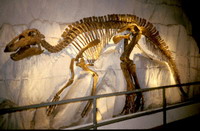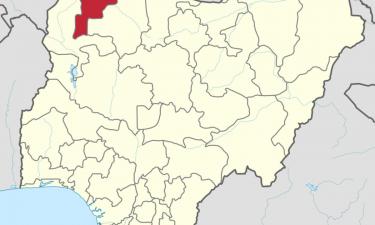Skeleton of giant plant-eating dinosaur uncovered in Argentina
The skeleton of a new dinosaur species - a 32 meter (105-foot) plant-eater that is among the largest dinosaurs ever found - has been uncovered in Argentina.

Scientists from Argentina and Brazil said the Patagonian dinosaur appears to represent a previously unknown species of Titanosaur because of the unique structure of its neck. They named it Futalognkosaurus dukei after the Mapuche Indian words for "giant" and "chief," and for Duke Energy Argentina, which helped fund the skeleton's excavation.
"This is one of the biggest in the world and one of the most complete of these giants that exist," said Jorge Calvo, director of paleontology center of National University of Comahue, Argentina, lead author of a study on the dinosaur published in the peer-reviewed Annals of the Brazilian Academy of Sciences.
Scientists said the giant herbivore walked the Earth some 88 million years ago, during the late Cretaceous period.
Researchers said the skeleton showed signs that the dinosaur had been devoured by predators. They believe the body then washed into a river, creating a barrier that collected the remains of other now fossilized animals found at the site.
Since the first bones were found on the banks of Lake Barreales in the Argentine province of Neuquen in 2000, paleontologists have dug up the dinosaur's neck, back region, hips and the first vertebra of its tail.
"I'm pretty certain it's a new species," agreed Peter Mackovicky, associate curator for dinosaurs at Chicago's Field Museum, who was not involved with the discovery. "I've seen some of the remains of Futalognkosaurus and it is truly gigantic."
Calvo said the neck alone must have been 17 meters (56 feet) long, and by studying the vertebrae, they figured the tail probably measured 15 meters (49 feet). The dinosaur reached over 13 meters (43 feet) tall, and the excavated spinal column alone weighed about 8 metric tons (9 tons) when excavated. One neck vertebra alone measured more than 1 meter (three feet) high.
Jeff Wilson, an assistant professor of paleontology at the University of Michigan, who was asked to review the finding, said he was impressed by the sheer amount of skeleton recovered.
"I should really try to underscore how incredible it is to have partial skeleton of something this size," Wilson said in telephone interview. "With these kind of bones you can't study them by moving them around on the table; you have to move around them yourself."
"It shows us the upper limit for dinosaur size," Wilson added. "There are some that are bigger but they all top out around this size."
Patagonia also was home to the other two largest dinosaur skeletons found to date - Argentinosaurus, at around 35 meters (115 feet) long, and Puertasaurus reuili, between 35 and 40 meters (115 feet to 131) feet long.
Comparison between the three herbivores, however, is difficult because scientists have only found few vertebrae of Puertasaurus and while the skeleton of Futalognkosaurus (FOO-ta-long-koh-SOHR-us) is fairly complete, scientists have not uncovered any bones from its limbs.
North America's dinosaurs don't even compare, Mackovicky added in a phone interview. "Dinosaurs do get big here, but nothing near the proportions we see in South America."
The site where Futalognkosaurus was found has been a bonanza for paleontologists, yielding more than 1,000 specimens, including 240 fossil plants, 300 teeth and the remains of several other dinosaurs.
Alexander Kellner, a researcher with the Brazilian National Museum and co-author of the dinosaur's scientific description, said investigators also found fossilized leaves that provide clues about the dinosaur's diet, and uncovered talons and part of an arm belonging to a carnivorous megaraptor at the site.
"As far as I know, there is no other place in the world where there is such a large and diverse quantity of fossils in such small area. That is truly unique," Kellner said.
Subscribe to Pravda.Ru Telegram channel, Facebook, RSS!




